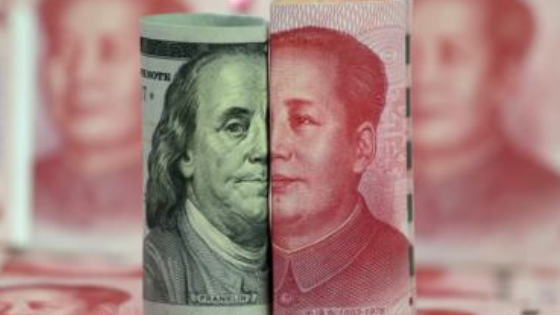Excerpt: U.S. products became globally competitive, and the U.S. trade deficit shrank. In 1988, Congress passed a law requiring the Treasury Department to issue twice-yearly reports identifying countries that manipulate their currencies
After a long delay, the Treasury Department just released its latest semi-annual report on global currency exchange policies. The congressionally mandated report provides an assessment of whether foreign countries are undervaluing their currencies to gain a trade advantage.
[Michael Stumo | June 1, 2019 | The Hill]
The major takeaway from the report is that Treasury has expanded the list of countries it is monitoring for exchange rate abuses. However, the department repeated its longstanding practice — and once again found no currency “manipulation” by America’s trade competitors.
In other words, Treasury believes that foreign central banks are not acting to push the U.S. dollar’s value up to noncompetitive levels.
Treasury is barking up the wrong tree, however. In the current market, the dollar is indeed being driven up, but by private capital inflows, not central banks — and it’s making U.S. exports too expensive in global markets.
Conversely, the currencies of America’s chief competitors — Japan, China and Europe — are too low. The result is that American-made cars, airplanes and other manufactured goods are getting priced out of the market through no fault of domestic U.S. companies.
The Treasury Department did acknowledge in its report that the dollar is overvalued and that other countries’ currencies are undervalued. The report also recognized that the dollar’s relative overvaluation drives the current U.S. trade deficit. Regrettably, Treasury offered no policy proposals to address this growing problem.
With America’s global trade deficit continuing to climb, the administration and Congress must recognize that the 21st century’s problem is no longer currency manipulation by foreign central banks.
Instead, a glut of private foreign capital is flowing into U.S. financial markets, continually driving the dollar higher, which allows foreign competitors to reap a windfall without lifting a finger. Wall Street perpetually cheers this strong dollar, but it is now working against American companies.
For those wondering why the U.S. trade deficit grew in 2018 despite President Trump’s aggressive trade intervention, it’s these capital inflows that are the root cause.
A wonkish explanation is needed to understand the problem. In the 1970s and 80s, Japan and West Germany followed a strategy that supercharged their economic growth.
They manipulated currency markets by buying dollar-based assets and sold their own currencies at the same time. The result was a rise in the dollar that made their exports comparably cheaper in the U.S. market.
In 1985, President Reagan faced the largest trade deficit in U.S. history. He responded to congressional pressure by negotiating with Japan and West Germany to stop their currency practices. The resulting agreement, the Plaza Accord, devalued the dollar significantly while raising the value of the yen and the Deutsche mark.
U.S. products became globally competitive, and the U.S. trade deficit shrank. In 1988, Congress passed a law requiring the Treasury Department to issue twice-yearly reports identifying countries that manipulate their currencies.
From the mid-1990s through 2015, China and other countries followed a similar nationalistic strategy, buying dollars and selling their own currencies to gain a trade advantage. But in recent years, a global oversupply of private capital flowing into the U.S. has started to do the job for them.
Some foreign countries use economic strategies to produce more than their citizens consume, and they export the difference. They generate trade surpluses and, as a result, accumulate progressively more savings than they invest at home.
Those surplus savings flow into countries with trade deficits, primarily the United States. This flood of “toxic waste” capital — as some economists describe it — buys Treasury bonds and U.S. stocks, which drives the dollar higher. And so, the U.S. trade deficit gets worse as American exports become less competitive.
Wall Street is happy to accept these private capital inflows in exchange for the stocks and bonds their brokers sell. But U.S. goods and services become too expensive in global markets, harming workers and hurting economic growth.
American companies lose market share to foreign competitors both at home and abroad, and they struggle to remain profitable — cutting budgets for innovative research and wage increases. It’s the key problem facing Main Street today.
While Treasury correctly found that there is no large-scale currency manipulation occurring among central banks, the department is focused on the wrong issue because these governments no longer need to push the dollar higher. International banks and hedge funds are doing the work for them.
One solution is a market access charge to manage this toxic influx of foreign capital. Like a peak load charge during rush hour traffic, a fee applied to incoming investment could slow foreign capital inflows, gradually lowering the dollar to a trade-balancing price. America would become competitive again in international trade and maintain its global leadership.
President Trump and Treasury Secretary Mnuchin cannot eliminate the U.S. trade deficit until they focus on these excessive foreign capital inflows, which are weaponizing the dollar against the interests of America’s companies and workers.
Solving this problem will allow the president to fulfill his campaign promise of narrowing the trade deficit and creating millions of good-paying, middle-class U.S. jobs for many years to come.
Michael Stumo is CEO of the Coalition for a Prosperous America (CPA).
Read the original article here.













